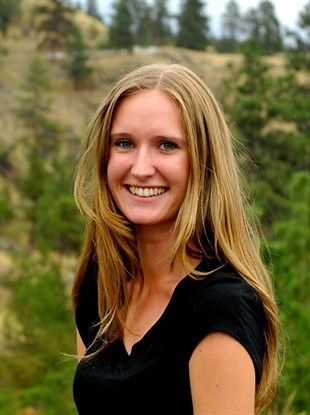
Charlotte Helston is the Vernon reporter for InfoNews.
(ADAM PROSKIW / iNFOnews.ca)
June 24, 2016 - 10:01 AM
OPINION
I was just a kid when my parents took me to watch the salmon run for the first time. I remember thinking we’d come too late and missed the show on account of the stinking, rotting fish I had to pick my way through in flimsy ballet flats on our way to the river. The fish were in various stages of slimy decay and the cloud of flies was so thick around them you could actually feel your face bumping into them.
After we made it through the corpses, I stood dutifully at the edge of the river watching other salmon that didn’t look much better than those on the beach basically swim in place against the current. It looked like they were making zero progress, and my boredom was growing by the minute.
My dad, teary-eyed with emotion, tried to explain how epic their journey is as they return from the ocean to spawn. For his sake, I nodded and said ‘cool, dad’ but beneath the facade I couldn’t help but wonder why so many people were taking pictures of these dying, stinky fish. Suffice it to say, I was not enamoured by the salmon run that day.
Some years later, I gave the whole thing another chance, this time at Goldstream Provincial Park in Victoria. There were still lots and lots of dead fish scattered about, but this time I saw as much life as I did death. I saw seagulls nibbling at the remains, while bald eagles scanned the pickings from overhead. A large mound of bear poop suggested there’d been a feast the night before. Even the flies and the maggots slowly eroding the carcasses were part of a huge web of life I was just beginning to see.
I watched one salmon in particular for at least 15 minutes. Chunks of its skin were hanging off and it looked like one of its eyeballs had been pecked out by a bird. It was in really terrible shape, but it was still fighting its way up the stream, every once in a while mustering the strength to jump out of the water, landing an inch or two closer to the place it would finally lay its eggs.
It’s a fighting battle for these fish the entire way against currents, swiping bear paws, and human activity. We’ve left a big footprint with our dams and developments. It’s harder now than ever before for salmon to complete their journey, a pilgrimage that sheds nutrients into the water and feeds a host of wildlife from the smallest insect to the ecosystem’s top predator.
Many groups, including those right here at home in the Okanagan, have been looking at this issue and working on restoration and conservation efforts so that salmon can continue to play their important role as a food source for many animals, including humans. And so there will be a salmon run to watch years from now.
But helping is a slippery slope. We saw how badly things turned out when the province introduced mysis shrimp into Okanagan Lake in the 1960s to help feed kokanee salmon. The plan backfired when the shrimp started competing with kokanee for food.
Our role in the salmon spawn is likely best left on the sidelines, as a spectator and not a meddler. The problem is, it might be too late for that.
If we do get involved — and since mankind has already inserted itself into this story we might have no choice — it must be with the utmost caution. So much hangs in the balance of this intricate web, and there are no doubt many links we are not even aware of yet. How we start to mend the ties without snapping more, I don’t know.
Perhaps we can all learn a little more by simply taking the time to watch nature do its thing and notice everything that’s at work. Maybe helping starts with stepping back and spectating for a bit before jumping in.
— Charlotte Helston is the Vernon reporter for iNFOnews.ca.
News from © iNFOnews, 2016